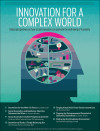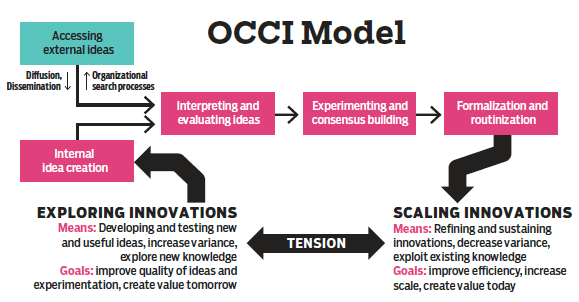
SUPPLEMENT TO SSIR FUNDED BY THE ROCKEFELLER FOUNDATION
Innovation for a Complex World

This special supplement includes seven articles by Judith Rodin and others, sharing global perspectives on how social innovation can promote the well-being of humanity.
-
Innovation for the Next 100 Years
-
Social Innovation and Resilience: How One Enhances the Other
-
Social Innovation Creates Prosperous Societies
-
Innovate and Scale: A Tough Balancing Act
-
Forging Ahead with Cross-Sector Innovations
-
Tapping the Entrepreneurial Potential of Grassroots Innovation
-
Embracing the Paradoxes of Innovation
The term social innovation captures our collective desires to find novel solutions to persistent social needs. The necessary innovations at a scale that matches the size of the problem can be enacted only by organizations. Social innovation is thus a crucial organizational topic.
Two issues are of concern. One relates to the challenge of scaling up successful innovations to truly make an impact at the scale of the needs they address. The second relates to the challenge of building a capacity in already established social-sector organizations for continuous innovation rather than “one-hit wonders.”
Before proceeding, we should be clear about what we mean by innovation. We define innovation as the process that starts with the emergence of an idea that is developed into a new set of organizational activities, technologies, products, or services, and their consequences for external stakeholders as well as the innovating organization.
Scaling and continuous innovation are fundamentally related in a counterintuitive manner: Scaling successful past innovations may make future innovations less productive, and ongoing cycles of innovation may make scaling less productive. Once an organizational innovation has succeeded in building a robust model for delivering needed products and services, subsequent scaling requires much incremental refinement, routinization, and standardization. Scaling thus requires focus and a commitment to the current operating model. On the other hand, continuous innovation is grounded in increasing the variance of ideas and experiments, challenging the status quo, and thinking and acting in fundamentally new ways.
The dual pressure of scaling the innovations of the past to achieve and demonstrate predictable impact today and exploring uncertain innovations for tomorrow creates a difficult balancing act. The ability to manage this tension fundamentally defines an organization’s capacity for continuous innovation (OCCI) and its ability to make an impact over time.
Unfortunately, the literature on OCCI in the social sector is thin and provides little guidance for social sector organizations. And our knowledge base is fragmented and lacks cumulative progress. In a recent workshop on this topic hosted by the Rockefeller Foundation,1 it became obvious that scholars and practitioners use multiple definitions of innovation (incremental change versus radical innovation, invention versus innovation), refer to different types of innovations (management/ operational, product/service, or business model), or focus on different levels of innovation (individuals, organizations, or ecosystems).
This diversity and ambiguity around how people think about innovation and the language used to capture elements of innovation unfortunately stifle progress. People often disagree or fail to find common ground because of different semantics rather than an exchange and evaluation of knowledge or experience.
The Anatomy of Organizational Innovation
To make progress in understanding OCCI, we developed an analytical model of organizational innovation processes. The model serves several purposes that are crucial for making progress in our understanding of OCCI in the social sector:
- To avoid ambiguity about what we mean by terms such as innovation or OCCI. The model defines OCCI clearly by specifying its sub-processes and their characteristics. It is a restricted lens, because many other things happen in organizations that are not considered. This enables comparative work on similar aspects across organizations.
- To encompass different types of innovation by being compatible with management or technical innovations as well as new products, services, or business models. The OCCI model is thus generic but can also be adapted to fit particular organizations.
- To bridge relevant levels including individuals, groups, organizations, and the external environment that collectively define the particular characteristics of OCCI. That way, realistic evaluations of OCCI and diagnosis of any external or internal enabling factors or those that may derail innovation can be made systematically and more objectively.
- To link organizational innovation processes with innovation outcomes in a dynamic manner that reflects on important feedback mechanisms between past and future innovation. This captures the fact that innovation has consequences not only for external stakeholders but also for the organization itself.
Organizational innovation is often portrayed as a stage model. It starts when individuals or small groups create novel ideas within organizations or access them from the environment. Ideas may also diffuse from their environments through diverse communication channels or may be actively disseminated through various relationship structures. Ideas need to be translated and communicated within organizations to groups of people, because individuals never have all the resources to develop them. Groups interpret and evaluate ideas through various lenses–for example, whether an idea fits and is appropriate (normative lens), whether it is feasible and needed (cognitive lens), whether now is the right time for it (strategic lens), or whether senior management or external powerful stakeholders such as funders will like it (political/power lens).
If an idea survives this initial stage, it needs to be given resources and enacted to determine its practical value. The latter outcome cannot be known in advance. This feature distinguishes innovation from many other organizational activities. Outcomes are uncertain and thus need to be experienced and learned. This experimentation stage is thus crucial to building broader consensus about the nascent innovation.

If consensus is positive the new set of activities is formalized into new structures, processes, technologies, and product and service offerings. The innovation needs to be fine-tuned and improved, usually through incremental changes to create value that justifies the efforts invested in creating it. That fine-tuning builds deep organizational routines and competencies that enable an organization to scale the innovation to meet its ambitions. Innovation thus becomes the new mainstream, and thereby an organization has changed in some important manner. (See “OCCI Model” below.)
A large number of external and internal factors shape and influence OCCI. They include organizational factors such as leadership and power characteristics, organizational mission and culture, levels of creativity, knowledge management and organizational competencies, and explicitness of an organization’s strategy. Many external factors have been shown to impact OCCI. They include the particular institutional context, the levels of competition and collaboration among the social organizations in the broader ecosystem, the ways in which organizations engage with the people and communities they serve, and the levels of trust and reputation that define these relationships. The model also explains the low success rate of innovations: Success depends on a complex constellation of many enabling external and internal factors at all stages concurrently, but even a single negative factor can derail innovation at any of these stages.
The Example of Sekem
To understand OCCI it is useful to look at the example of one organization, Sekem, in some detail. Sekem is an Egyptian social sector organization that over the course of 30 years transformed a strip of desert north of Cairo into a thriving agricultural community. Sekem is composed of several businesses based on organic agriculture along with nonprofit organizations such as a medical center, kindergartens, schools, a recently opened university, and a biodynamic-agriculture certification body. To create this community, Sekem had to manage the difficult job of balancing innovation and scaling up. Three factors conspired to almost derail their innovations.
Factors based on cognitive hurdles | When Sekem began exploring biodynamic agriculture in Egypt in the 1970s, neither the farmers nor the government thought that it was a valuable proposition. The farmers believed that it was not economically valuable and did not cooperate. The government authorities stopped initial attempts to cultivate the land, arguing that using cow dung to build up organic soil would contaminate the soil with dangerous bacteria. It took years to convince these stakeholders that biodynamic agriculture was feasible and would improve soil quality. Today, Sekem has a number of profitable companies that produce high-quality food and enable farmers to move out of unprofitable subsistence farming. The trust, reputation, self-confidence, and knowledge developed by these almost failed innovations were the basis for subsequent innovations and building Sekem’s OCCI. For example, the idea of pioneering biodynamic cotton agriculture in Egypt was supported by the government because of the trust built during Sekem’s successful introduction of biodynamic farming.
Factors based on normative hurdles | Sekem’s early innovations were threatened by a lack of productive workers. Most employees from poor communities did not consider it “normal” to show up at work predictably and on time, attributes required for building a productive and sustainable organization. Through much trial and error, Sekem found a collective action mechanism to achieve this goal. Every organization of the Sekem group forms a morning circle consisting of all employees. Not being at work on time is now highly visible and embarrassing for individual workers. This mechanism created new templates for role behavior required for efficient economic activities. It built Sekem’s capacity for instilling new rules and monitoring behavior, creating a greater ability to innovate and scale and to enable OCCI through productive human resources. Today, Sekem employees understand that they are the drivers for innovation. They have the requisite communication channels, processes, and resources to evaluate and test ideas.
Factors based on political/power hurdles | In its early years Sekem ran into disputes with the local Bedouin over land-use rights. The Bedouin, who were nomadic and lived outside the regulatory norms of the country, challenged Sekem’s rights to the land it had acquired. Settling this dispute was close to a life-or-death endeavor that severely challenged the organization’s motivation to proceed. A few years later, the military occupied and started bulldozing the land on which Sekem had built its first farms, almost eliminating any hope for progress. But Sekem demonstrated commitment and perseverance, which earned it respect and made it less vulnerable. Sekem also engaged in a strategy to build up organizational size and complexity. It created a microcosm of different types of for-profit and not-for-profit organizations and linked up closely with external partners in Egypt and abroad. This strategy created a more resilient and controlled environment, which enabled more productive innovation over time.
The ability to access many different types of resources enabled Sekem to invest more time and effort in exploring risky innovations. The willingness to stay with these innovations and make them work created tremendous learning and also relational resources that enabled Sekem to innovate more productively over time and thus increase its OCCI.
Mapping OCCI and Its Pathologies
Scholars have voiced concerns over the expectations for “social engineering” as implied by the literature on so-called innovation success factors, which suggests that innovation in organizations can be predictably designed. Sekem reminds us how difficult and risky innovation is. Innovation depends on the ability to make a plan work through much effort, investment of resources, and a lot of luck. Innovations rarely work as intended. We believe that the discovery of unintended consequences of our innovation processes and the circumstances of their workings represent an important approach for significant progress toward a realistic understanding of social innovation.
Our OCCI model can be used as a diagnostic instrument to account for factors that could derail innovation. A large number of these “innovation pathologies” have been documented.2 Working directly with organizations, we may explore some of the following pathologies.3
Idea creation/access—individual level | Do people misunderstand an organization’s mission and vision? Do people lack motivation or insights because, for example, they are too far removed from the front line? Are people too stressed to reflect on their work and the organization’s future? Is the organization driven by setting and meeting targets? Are there signs of the “not invented here” syndrome? Do people fear punishment for potential failures, or are they never recognized for good ideas? Do the most innovative people tend to leave the organization? Are the workforce and management too homogeneous?
Interpretation and evaluation—group level | Are groups built ad hoc, so that there is no consistency and learning in evaluating ideas? Are participants in groups too competitive, so that there is no trust? Are managers overconfident in existing practices? Do senior managers suffer from too-rigid beliefs, values, and assumptions? Do status, cultural, or language barriers prevent efficient and open communication?
Experimenting and consensus building—group level | Are responsibilities for execution unclear? Are people expected to pilot projects “on the side”? Are resources withdrawn from prototypes too early or ad hoc? Do projects that don’t work tend to be sustained for too long (failure traps)? Does failure trigger blaming people rather than acknowledging the inherent uncertainty of innovation and learning from it? Is learning from success and failure superstitious and irrational rather than objective and systematic?
Formalization and scaling—organizational level | Do innovations remain invisible to headquarters, for example in very decentralized organizations? Does a power and leadership vacuum prevent successful innovations from being formalized and adopted? Do organizations have inadequate critical execution competencies? Do rapid cycles of innovation prevent sufficient development of the outcomes of innovation processes?
External stakeholders—task environment level | Do funders push organizations in directions that conflict with their sense of identity? Do funders incentivize organizations to “sell” everything they do as an innovation rather than pursuing real innovation? Do impatience, short-termism, and requirements for reporting impact metrics stifle investments in experimentation, failure, and learning? Does a hostile environment stifle efforts at innovation by aggressive or even illegal actions? Are sufficient resources accessible for enabling innovations and making the “waste” created by failures inherent to innovation affordable?
Conclusion
Innovation is risky, difficult, and in many ways unpredictable. It competes with other ways of creating value, such as focusing on many small improvements over time.4 Getting better at innovation and making innovation more productive are the keys to realizing its potential. Almost all organizations that have operated for some time accumulate structural, behavioral, or strategic barriers to making innovation productive. Getting good at diagnosis and finding ways to eliminate the causes of pathologies increase OCCI. Unfortunately, we are much more likely to talk about successes and achievements than we are to talk about failures and weaknesses.
Creating new products, services, and processes is important, but it is equally important that organizations fully exploit, develop, and scale past innovations to maximize their value potential. Constantly pushing for innovation is counterproductive. But so is getting too cozy with the predictability and convenience of the old ways and losing the motivation and skills required for productive innovation. Learning how to balance these two competing organizational processes is an important task for the entire social sector.
Support SSIR’s coverage of cross-sector solutions to global challenges.
Help us further the reach of innovative ideas. Donate today.
Read more stories by Christian Seelos & Johanna Mair.

